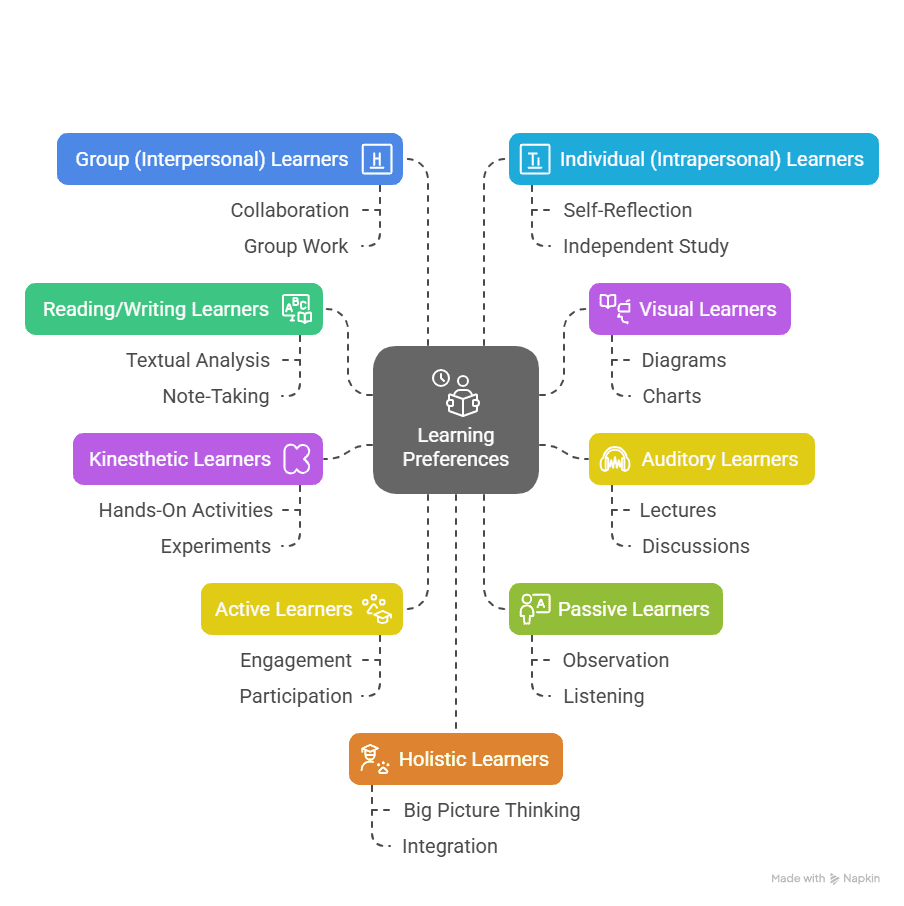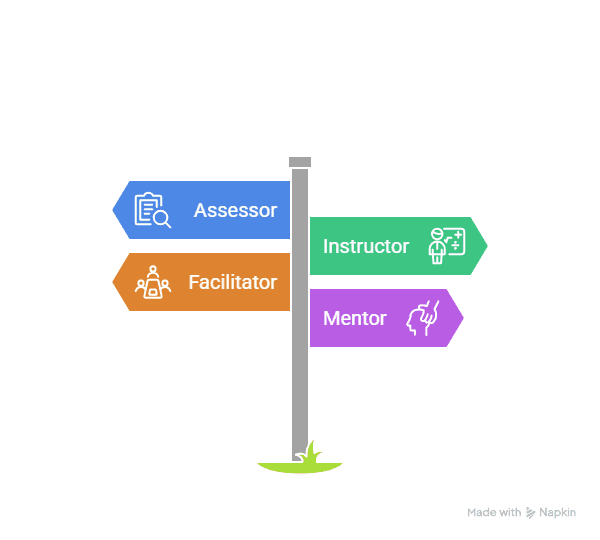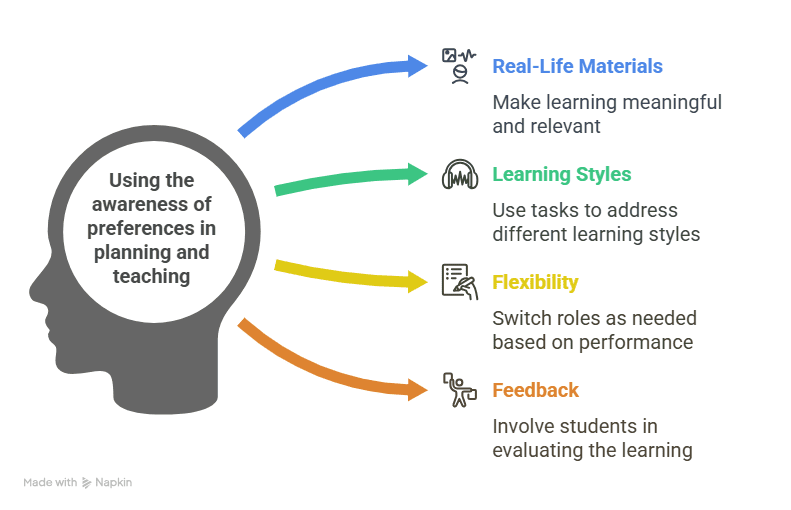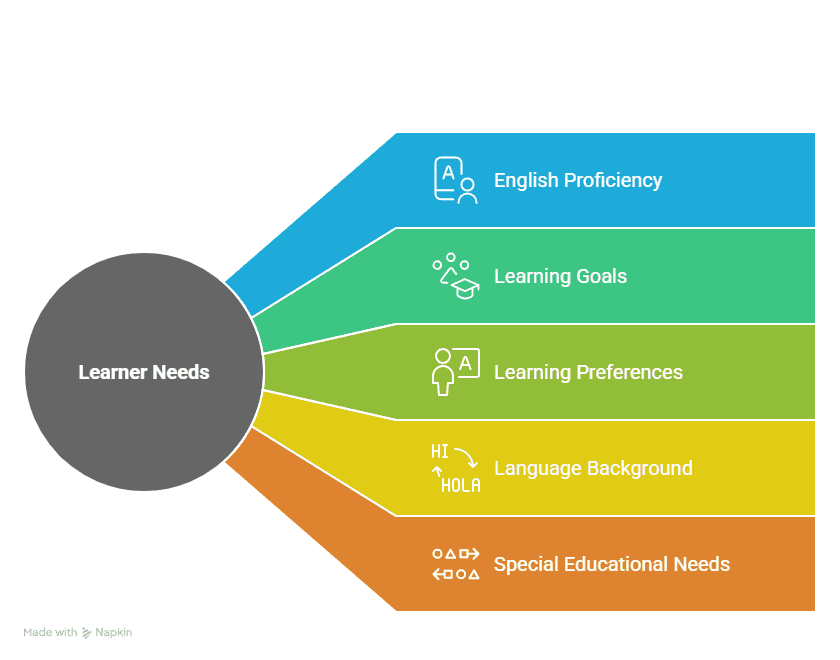Learning and teaching preferences

Teaching English to adults isn’t a one-size-fits-all process. Every student has unique learning preferences, and as teachers, we need to adapt our roles and methods to meet their needs. In this lesson, we’ll explore the different learning preferences adults bring to the classroom, the various roles teachers can play, and how to use this knowledge to plan and teach effectively.
- Learning and teaching preferences
- What are learning preferences?
- The different roles of a teacher
- How to use the awareness of preferences in planning and teaching
- Keeping students engaged and motivated while maintaining their preferences
- A CELTA trainee’s perspective
- Final thoughts
- To your CELTA journal
What are learning preferences?

Learning preferences refer to the ways individuals prefer to absorb, process, and retain information. Understanding these preferences helps teachers create lessons that resonate with their students. Here are some common types:
Reading/Writing Learners
Reading/writing learners prefer working with written words—both for input (reading) and output (writing). They often excel in activities that involve reading texts, taking notes, and writing down information. These learners tend to process information through language itself, especially written language.
ESL Example: They enjoy reading comprehension exercises, grammar explanations in written form, and written instructions. They may prefer writing practice over speaking and benefit from essay writing, written reflections, and completing workbook exercises. After reading a dialogue, they enjoy rewriting it in their own words or summarizing the text in a paragraph.
Visual Learners
Visual learners understand and remember information better when it is presented visually. They rely heavily on images, colors, spatial arrangements, and the organization of written content.
ESL Example: Visual aids like charts, diagrams, timelines, and infographics help them grasp complex structures or vocabulary. They benefit from color-coded grammar rules, visual storyboards, or subtitled videos. While learning phrasal verbs, they might benefit from a comic strip showing characters using each phrasal verb in context.
Auditory Learners
Auditory learners learn best through listening. They process information by hearing and speaking, and often remember what they hear more easily than what they see or read.
ESL Example: They benefit from listening activities, pronunciation practice, and discussions. Songs, chants, and audiobooks help with retention. They may remember new vocabulary better after hearing it in a dialogue and then repeating it aloud.
Kinesthetic Learners
Kinesthetic learners learn by doing. They prefer physical activities and hands-on experiences. These learners often need to move or physically engage with learning materials to stay focused and retain information.
ESL Example: Role-plays, games, classroom movement tasks (like mingling or vocabulary races), and use of realia are highly effective. TPR (Total Physical Response) is particularly suited to this type. They learn vocabulary like “jump,” “run,” and “clap” best by physically performing the actions while saying the words.
Active Learners
Active learners prefer to participate directly in learning. They enjoy engaging in discussions, experimenting with language, and taking risks. They often thrive in tasks where they can do something with what they’ve learned.
ESL Example: They do well in group projects, debates, simulations, and task-based activities. They like being involved and challenged, rather than passively receiving information. An active learner may love taking part in a classroom debate where they must use persuasive language structures.
Passive Learners
Passive learners prefer to observe and reflect before participating. They often need time to think and prepare before they feel ready to contribute. These learners may not be vocal, but they are often thoughtful and methodical.
ESL Example: They benefit from clear modeling, examples, and reflection time. Silent reading, grammar exercises, and writing tasks suit their pace. Before joining a speaking task, they may want to prepare notes or silently rehearse their ideas.
Group (Interpersonal) Learners
Group learners thrive when they collaborate and interact with others. They enjoy exchanging ideas and learning through social engagement. Their learning is enhanced by communication and cooperation.
ESL Example: Pair work, group discussions, peer editing, and collaborative games are ideal. They tend to contribute actively in group settings and learn from peer feedback. A group learner may enjoy co-writing a dialogue or brainstorming vocabulary as a team.
Individual (Intrapersonal) Learners
Individual learners prefer to work independently and reflect on their own progress. They are often self-directed and motivated by personal goals. They need quiet time and space to process new information.
ESL Example: Solo reading, writing journals, and self-assessment tools help them thrive. They like setting personal learning goals and tracking their own improvement. They may prefer writing a reflective blog post in English rather than presenting ideas in a group discussion.
Holistic Learners
Holistic learners prefer to understand the overall meaning or context before focusing on the details. They are big-picture thinkers who benefit from starting with general concepts or real-life contexts.
ESL Example: They do well with theme-based lessons, storytelling, and real-world tasks. They need to see the relevance of what they’re learning before engaging with rules or drills. When teaching conditionals, a holistic learner might enjoy first discussing “What would you do if you won the lottery?” before looking at form and structure.
Discovery-Oriented Learners
Discovery learners enjoy exploring language patterns and figuring things out themselves. They learn best through guided exploration, problem-solving, and experimentation.
ESL Example: Inductive grammar tasks, context-based vocabulary learning, and open-ended projects are suitable. They like to ask “why” and uncover rules through observation. Instead of being told the rules for the past simple, they prefer to look at multiple examples in context and deduce the pattern themselves.
A real-world example:
In a mixed class, you might have a visual learner who struggles with listening exercises but excels when you use flashcards or videos. Meanwhile, a kinesthetic learner might find it hard to sit still during a lecture but shine in a group activity where they can move around.
The different roles of a teacher

As teachers, we wear many hats depending on the needs of our students and the context of the lesson. Here are some roles you might adopt:
The Assessor
In this role, you evaluate students’ language progress and provide constructive feedback to help them improve. Assessment can be formal or informal and helps identify both strengths and areas for development.
ESL Examples:
- After a pair speaking activity, you might listen closely and note down examples of correct usage as well as errors in pronunciation or grammar, then give targeted feedback.
- During a writing lesson, you might use a checklist to assess learners’ use of paragraphing, coherence, and appropriate vocabulary.
- You could also design a short end-of-unit quiz to check understanding of key vocabulary and grammar points.
The Instructor
This is the more traditional, directive role where you teach by explaining, demonstrating, and guiding practice. You are the main source of input and clarification.
ESL Examples:
- When teaching the past continuous tense, you might draw a timeline on the board and explain when and how the tense is used, followed by example sentences.
- During pronunciation practice, you might model individual sounds or stress patterns, and ask students to repeat after you.
- You might also demonstrate how to write a formal email, pointing out structure, register, and useful phrases.
The Facilitator
Here, you shift the focus from yourself to the learners, providing the resources, environment, and support they need to explore, discover, and use the language actively and autonomously.
ESL Examples:
- In a vocabulary lesson, you might give students a reading passage and ask them to deduce the meaning of new words from context, instead of pre-teaching the vocabulary.
- During a speaking activity such as a role-play or debate, you may observe quietly while students interact, only stepping in if they ask for help or go off-task.
- You might set up a jigsaw reading task where each group reads a different part of a text, then shares information with others to complete the full picture.
The Mentor
In this supportive role, you focus on students’ emotional and motivational needs. You offer guidance, encouragement, and personal support to help them grow as learners.
ESL Examples:
- During class, you may praise a shy student for participating, reinforcing their confidence and encouraging continued effort.
- When a student feels discouraged about their speaking ability, you might share your own experiences of learning a language and suggest small achievable goals, like starting conversations with classmates.
- You might meet with a student individually to help them plan strategies for passing an English exam or managing study time effectively.
A real-world example:
During a lesson on business English, you might start as an instructor by teaching formal email etiquette, then switch to a facilitator role as students practice writing emails in pairs. Later, you might act as a mentor by giving personalized tips to a student who’s nervous about presenting in English.
How to use the awareness of
preferences in planning and teaching

Use Real-Life Materials focusing on Their Preferences
Connect lessons to your learners’ backgrounds, goals, and real-world needs to make learning meaningful and relevant.
Examples:
- If your students are working professionals, include role-plays of workplace scenarios, such as job interviews, meetings, or giving presentations.
- For young adults or teenagers, use social media posts, YouTube videos, or song lyrics to teach vocabulary and grammar in context.
- If your learners are preparing for immigration or travel, use authentic materials like airport signs, menus, or forms to develop functional language skills.
Mix It Up of Preferences and Learning Styles
Incorporate a variety of tasks and materials to address different learning preferences and keep students engaged.
Examples:
- Begin with a visual stimulus like a short video or infographic to introduce a topic.
- Move on to an auditory activity like listening to a dialogue and identifying key expressions.
- Include a reading/writing task where students fill in a worksheet or summarize what they’ve learned.
- Add a kinesthetic task such as moving around the room to match vocabulary cards or acting out a scene.
- Use group work for interpersonal learners and allow individual reflection time for intrapersonal learners.
- Incorporate a discovery task, like finding grammar patterns in a dialogue, for analytical or discovery-oriented learners.
Be Flexible
Switch roles as needed based on student performance, the activity type, and lesson objectives.
Examples:
- If your students are confused about verb tenses, step into the instructor role to clearly explain and model usage with timelines and examples.
- When they’re ready to apply the language, become a facilitator, letting them work in pairs or groups while you monitor and provide gentle correction as needed.
- Adopt the mentor role when students express frustration or doubt—help them set goals and remind them of their progress.
- Play the assessor role periodically, through short quizzes, peer feedback, or informal observation, to track learning and adjust future lessons.
Get Feedback
Make feedback a two-way process by involving students in evaluating the learning experience.
Examples:
- Let students co-create classroom routines or vote on project topics to increase engagement and sense of ownership.
- After a new activity, ask students which part they found most useful and which was challenging.
- Use exit slips where learners write one thing they learned and one question they still have.
- Have regular check-ins (especially in small classes) to ask about their learning preferences—Do they prefer group or solo work? Do visuals help them? Would they like more listening practice?
A real-world example:
Imagine teaching a class of adult learners who are preparing for the IELTS exam. You could start with a visual presentation of the test format (for visual learners), follow it with a listening practice (for auditory learners), and then have students work in pairs to simulate the speaking test (for kinesthetic learners).
Keeping students engaged and
motivated while maintaining their preferences

Show Progress
Help students reflect on how far they’ve come and recognize their own growth. This reinforces the idea that effort leads to improvement, which is a powerful motivator.
Examples:
- Keep a learning portfolio where students collect samples of their work (e.g., written assignments, speaking recordings) and periodically review them to notice improvement.
- Use “can-do” checklists based on lesson outcomes. For example, after a unit on giving directions, let students tick off “I can give and understand directions in English.”
- Begin lessons with a quick recap of what students have already mastered—this reinforces prior learning and gives a sense of achievement.
Celebrate Strengths
When students feel capable in certain areas, they’re more likely to take risks and engage with new challenges. Public and private recognition can go a long way.
Examples:
- If a student is especially articulate in speaking tasks, acknowledge this in front of the class and ask them to model an answer.
- If a student has a talent for writing, assign them as a “peer reviewer” during a writing workshop.
- Create a “skills wall” in the classroom where you post examples of student work that demonstrate various abilities—writing, creativity, teamwork, pronunciation, etc.
Challenge Weaknesses
Growth happens when students stretch beyond their comfort zones—but this needs to be done in a supportive and strategic way.
Examples:
- For a student who excels at grammar exercises but avoids speaking, design a safe environment for practice—such as a prepared dialogue with a partner, or voice recordings instead of live speaking.
- Use role-play or drama activities to help shy students become more comfortable speaking in front of others.
- Set personalized mini-goals. For instance, “This week, try to ask at least one question in class,” or “Participate in one group discussion.”
Make It Fun
Enjoyable learning experiences are more memorable and reduce anxiety—especially important for language learners. Fun activities also create a positive emotional connection to the language.
Examples:
- Rotate roles in pair and group work to ensure everyone gets a chance to lead, support, and participate in different ways.
- Use games like vocabulary bingo, charades, or “Find someone who…” to review content while promoting movement and interaction.
- Include creative tasks, like making posters, writing a class poem, or designing comic strips to practise grammar in context.
- Organize friendly competitions, such as team quizzes or speaking challenges, to energize students and build team spirit.
A real-world example:
A student who’s shy about speaking might feel more comfortable in a small group activity rather than a whole-class discussion. By gradually increasing the size of the audience, you can help them build confidence over time.
A CELTA trainee’s perspective

What would you want to find out about a group of learners that you had to teach so that you could plan your lessons?
Level of English
As a CELTA trainee, I believe that getting to know my learners is essential for planning effective, engaging lessons. There are several things I would want to find out before I start teaching a group. First, I’d want to know their level of English—not just generally (like A2 or B1), but specifically which skills they’re stronger or weaker in, such as speaking fluency, listening comprehension, grammar accuracy, or vocabulary range.
Learning goals and motivations
I’d also want to know about their learning goals and motivations. Are they learning English for work, study, travel, or just for fun? This would help me make sure my lessons are meaningful and relevant to them. For example, a learner who needs English for an office job might benefit from practicing emails and formal language, while someone preparing for travel might need more functional phrases for everyday situations.
Learning preferences and personalities
Another important thing I’d want to find out is their learning preferences and personalities. Some learners might enjoy pair work and group discussions, while others may feel more comfortable with individual tasks. Knowing this would help me plan varied activities that cater to different types of learners.
First language (L1) and special educational needs
In addition, I’d try to find out about their first language (L1) background and whether they’ve learned other languages before. This might help me anticipate potential errors or pronunciation issues. Lastly, I’d want to be aware of any special educational needs or personal circumstances that might affect their learning so I can be sensitive and inclusive in my approach.
How would you find out?
There are a few ways I would go about finding out this information. One of the first things I’d do is look at any placement test results or needs analysis forms provided by the school or centre. These can give a general idea of learners’ levels and goals.
An informal needs analysis
At the beginning of the course, I’d also try to conduct some informal needs analysis activities, such as short questionnaires or getting learners to share their reasons for learning English in pairs or groups. These could be done as speaking or writing tasks, which would also help me observe their language use in a natural context.
Close observation
I’d pay close attention to learners during the first few lessons, observing how they respond to different tasks and interact with each other. I think this kind of observation can tell me a lot about their confidence levels, participation style, and any particular strengths or difficulties they have.
One-on-one conversations
If possible, I’d also have brief, friendly conversations with learners one-on-one, especially if someone seems shy or reluctant to participate. I’d want to create a supportive environment where they feel safe to express themselves, both in terms of language and personal preferences.
Overall, I think it’s important to see this process as ongoing. I wouldn’t expect to know everything about my learners right away, but rather continue learning about them as we go through the course together, adjusting my lessons as needed to better suit their needs.
Final thoughts
Teaching English to adults is a dynamic and rewarding process. By understanding their learning preferences, adapting your role, and planning lessons that cater to their needs, you can create a classroom where every student feels supported and motivated.
Remember, the best teachers are those who are flexible, empathetic, and willing to learn from their students. So, embrace the diversity in your classroom, and enjoy the journey of helping your students achieve their goals!
To your CELTA journal
What’s your experience with different learning preferences?
Reflect on your experience with different learning preferences. Write in your CELTA journal about how adult learners in your classroom prefer to learn (e.g., visual, auditory, kinesthetic, reflective). Share examples of strategies you have used to support these preferences and keep learners engaged. Include any tips or insights on adapting lessons to meet diverse learning needs.
- Next lesson: Context for learning and teaching English
- Previous lesson: Motivations for learning English as an adult
